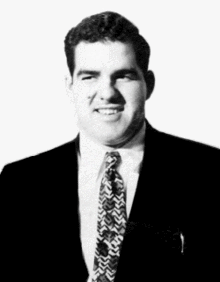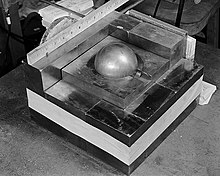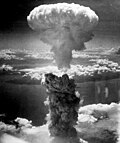Harry Daghlian
Harry Daghlian | |
|---|---|
 Daghlian c. 1944 | |
| Born | May 4, 1921 Waterbury, Connecticut, U.S. |
| Died | September 15, 1945 (aged 24) Los Alamos, New Mexico, U.S. |
| Cause of death | Radiation poisoning |
| Resting place | Cedar Grove Cemetery, New London, Connecticut, U.S. |
| Education | Bachelor of Science |
| Alma mater | Purdue University |
| Occupation | Physicist |
Haroutune Krikor Daghlian Jr. (May 4, 1921 – September 15, 1945) was an American physicist with the Manhattan Project, which designed and produced the atomic bombs that were used in World War II. He accidentally irradiated himself on August 21, 1945, during a critical mass experiment at the remote Omega Site of the Los Alamos Laboratory in New Mexico, and died 25 days later from the resulting radiation poisoning.

Daghlian was irradiated as a result of a criticality accident that occurred when he accidentally dropped a tungsten carbide brick onto a 6.2 kg plutonium–gallium alloy bomb core. This core, subsequently nicknamed the "demon core", was later involved in the death of another physicist, Louis Slotin.
Early life[]
Haroutune Krikor Daghlian Jr., of Armenian-American descent, was born in Waterbury, Connecticut, on May 4, 1921, one of three children of Margaret Rose (born as Currie) and Haroutune Krikor Daghlian. He had a sister, Helen, and a brother, Edward.[1] Soon after his birth the family moved across state to the coastal town of New London, Connecticut. He was educated at Harbor Elementary School, where he played violin in the school orchestra, and at Bulkeley High School. In 1938, at the age of 17, he entered the Massachusetts Institute of Technology, intending to study mathematics,[2] but became interested in physics, particularly particle physics, then emerging as an exciting new field. This interest led him to transfer to the West Lafayette, Indiana, campus of Purdue University, where he graduated with a Bachelor of Science degree in 1942. He then commenced work on his doctorate, assisting Marshall Holloway with the cyclotrons. In 1944, while still a graduate student, he joined Otto Frisch's Critical Assembly Group at the Los Alamos Laboratory of the Manhattan Project.[3][4]

Criticality accident[]

During an experiment on August 21, 1945, Daghlian was attempting to build a neutron reflector manually by stacking a set of 4.4-kilogram (9.7 lb) tungsten carbide bricks in an incremental fashion around a plutonium core. The purpose of the neutron reflector was to reduce the mass required for the plutonium core to attain criticality. He was moving the final brick over the assembly, but neutron counters alerted Daghlian to the fact that the addition of that brick would render the system supercritical. As he withdrew his hand, he inadvertently dropped the brick onto the center of the assembly. Since the assembly was nearly in the critical state, the accidental addition of that brick caused the reaction to go immediately into the prompt critical region of neutronic behavior. This resulted in a criticality accident.[5][failed verification][6]
Daghlian reacted immediately after dropping the brick and attempted to knock the brick off the assembly without success. He was forced to disassemble part of the tungsten-carbide pile in order to halt the reaction.[7]
Daghlian was estimated to have received a dose of 510 rem (5.1 Sv) of neutron radiation, from a yield of 1016 fissions.[5] Despite intensive medical care, he developed symptoms of severe radiation poisoning, and his mother and sister were flown out to care for him (his father had died in 1943).[2] He fell into a coma and died 25 days after the accident.[7][6] He was the first known fatality caused by a criticality accident. His body was returned to New London, where he was buried at Cedar Grove Cemetery.[8]

Legacy[]
As a result of the incident, safety regulations for the project were scrutinized and revised. A special committee was established to review any similar experiments and recommend appropriate safety procedures. This change of procedures included needing a minimum of two people involved in such an experiment, using at least two instruments monitoring neutron intensities with audible alerts, and preparing a plan for operating methods and any contingencies that might occur during similar experiments.[9][failed verification] Additionally, discussions and designs for remote-controlled test devices were initiated, eventually leading to the creation of the Godiva device.[citation needed]
These changes did not prevent another criticality accident from happening at Los Alamos the following year. Louis Slotin, a colleague of Daghlian's, was killed in 1946 while performing criticality tests on the same plutonium core.[5] After these two incidents it became known as the "demon core",[10][unreliable source?][self-published source] and all similar criticality experiments were halted until remote-controlled assembly devices were more fully developed and available.[9]
Daghlian was memorialized on May 20, 2000, by the city of New London, with the erection of a memorial stone and flagpole in Calkins Park, which was unveiled by his brother and sister. It read: "though not in uniform, he died in service to his country."[1][8][11][unreliable source?][self-published source]
References[]
- ^ a b "Harry K. Daghlian". Soylent Communications. Archived from the original on May 13, 2016. Retrieved August 15, 2015.
- ^ a b Baumann, Paul (August 6, 1985). "NL man was 1st victim of atomic experiments". The Day. pp. 1, 4. Retrieved August 15, 2015.
- ^ "Harry Daghlian". Atomic Heritage Foundation. Archived from the original on August 30, 2015. Retrieved August 15, 2015.
- ^ "Harry Daghlian, Jr., wins Purdue honor". The Day. April 1, 1941. p. 3. Retrieved August 15, 2015.
- ^ a b c d McLaughlin, Thomas P.; Monahan, Shean P.; Pruvost, Norman L.; Frolov, Vladimir V.; Ryazanov, Boris G.; Sviridov, Victor I. (May 2000), A Review of Criticality Accidents (PDF), Los Alamos, New Mexico: Los Alamos National Laboratory, pp. 74–75, LA-13638, archived (PDF) from the original on September 27, 2007, retrieved April 21, 2010
- ^ a b Sullivan, Neil J. (2016). The Prometheus Bomb: The Manhattan Project and Government in the Dark. Lincoln: University of Nebraska Press. pp. 14–16. ISBN 978-1-61234-890-2. Retrieved November 30, 2021.
- ^ a b Miller, Richard L. (1991). Under the Cloud: The Decades of Nuclear Testing. The Woodlands, Texas: Two Sixty Press. pp. 68, 69, 77. ISBN 0-02-921620-6.
- ^ a b Slosberg, Steven (June 8, 2000). "A quiet victim of a horrific war he helped end". The Day. p. C1. Retrieved August 15, 2015.
- ^ a b Hayes, Daniel F. (August 1956). "A Summary of Accidents and Incidents Involving Radiation in Atomic Energy Activities, June 1945 through December 1955". Oak Ridge, Tennessee: U.S. Atomic Energy Commission: 2–3. doi:10.2172/4343762. OSTI 4343762. TID-5360. Retrieved August 8, 2015. Cite journal requires
|journal=(help) - ^ Wellerstein, Alex. "The Third Core's Revenge". Restricted data blog. Archived from the original on April 7, 2014. Retrieved April 4, 2014.{unreliable inline}}[self-published source]
- ^ Dion, Arnold S. "Harry Daghlian: America's first peacetime atom bomb fatality". Retrieved April 13, 2010.[unreliable source?][self-published source]
External links[]
 Media related to Haroutune Krikor Daghlian, Jr. at Wikimedia Commons
Media related to Haroutune Krikor Daghlian, Jr. at Wikimedia Commons- Harry Daghlian at Find a Grave
- 1921 births
- 1945 deaths
- Accidental deaths in New Mexico
- American nuclear physicists
- American people of Armenian descent
- Armenian physicists
- Deaths from laboratory accidents
- Manhattan Project people
- People from Los Alamos, New Mexico
- People from Waterbury, Connecticut
- People from New London, Connecticut
- Plutonium
- Purdue University alumni
- Victims of radiological poisoning
- Burials at Cedar Grove Cemetery (New London, Connecticut)
